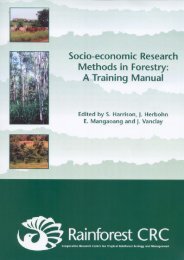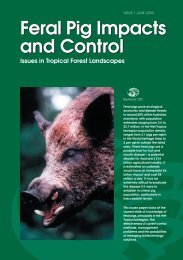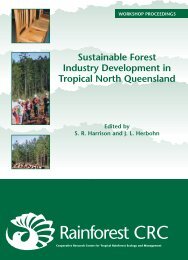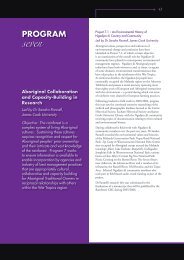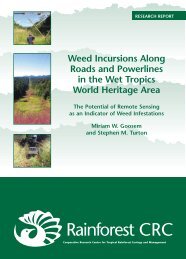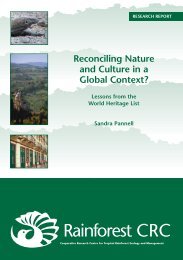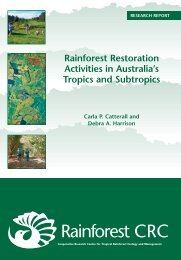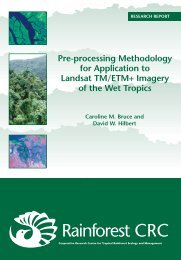Reconciling Nature and Culture in a Global Context? - Rainforest ...
Reconciling Nature and Culture in a Global Context? - Rainforest ...
Reconciling Nature and Culture in a Global Context? - Rainforest ...
Create successful ePaper yourself
Turn your PDF publications into a flip-book with our unique Google optimized e-Paper software.
<strong>Reconcil<strong>in</strong>g</strong> <strong>Nature</strong> <strong>and</strong> <strong>Culture</strong> <strong>in</strong> a <strong>Global</strong> <strong>Context</strong>?Lessons from the World Heritage ListCHAPTER FIVE – ‘NATURAL’ CULTURALLANDSCAPES: THE CASE OF VAL D’ORCIA,TUSCANYThere exist a great variety of L<strong>and</strong>scapes that are representative of thedifferent regions of the world. Comb<strong>in</strong>ed works of nature <strong>and</strong> humank<strong>in</strong>d, theyexpress a long <strong>and</strong> <strong>in</strong>timate relationship between peoples <strong>and</strong> their naturalenvironment – ICOMOS, World Heritage Cultural L<strong>and</strong>scapesVal d’Orcia <strong>in</strong> the prov<strong>in</strong>ce of Siena, Tuscany, is the most recently <strong>in</strong>scribed ‘culturall<strong>and</strong>scape’ on the World Heritage List. Val d’Orcia was orig<strong>in</strong>ally nom<strong>in</strong>ated by the ItalianGovernment on the basis of four cultural criteria (ii, iii, iv <strong>and</strong> vi). However, the placement ofthe valley formed by the Orcia River on the List <strong>in</strong> 2004 was eventually justified <strong>in</strong> terms ofjust two, (iv) <strong>and</strong> (vi), of the ten criteria outl<strong>in</strong>ed <strong>in</strong> the Operational Guidel<strong>in</strong>es for theImplementation of the World Heritage Convention for ‘outst<strong>and</strong><strong>in</strong>g universal value’. As suchVal d’Orcia is described as an “exceptional reflection of the way l<strong>and</strong>scape was rewritten <strong>in</strong>Renaissance times to reflect the ideals of good governance <strong>and</strong> to create an aestheticallypleas<strong>in</strong>g picture” <strong>and</strong> as a l<strong>and</strong>scape “celebrated by pa<strong>in</strong>ters from Siennese School. In thislast regard, the World Heritage <strong>in</strong>scription states that “images of the Val d’Orcia, <strong>and</strong>particularly depictions of l<strong>and</strong>scapes where people are depicted as liv<strong>in</strong>g <strong>in</strong> harmony withnature […] have profoundly <strong>in</strong>fluenced the development of l<strong>and</strong>scape th<strong>in</strong>k<strong>in</strong>g” (ICOMOS2004: 136).Val d’Orcia, together with a number of other World Heritage properties, <strong>in</strong>clud<strong>in</strong>g the‘Agricultural L<strong>and</strong>scape of Southern Öl<strong>and</strong>’ (2000), the ‘Viñales Valley’ <strong>in</strong> Cuba (1999), the‘Costiera Amalfitana’ <strong>and</strong> ‘Portovenere, C<strong>in</strong>que Terre, <strong>and</strong> the Isl<strong>and</strong>s’ of Italy (both listed <strong>in</strong>1997), the ‘Alto Douro W<strong>in</strong>e Region’ of Portugal (2001), <strong>and</strong> the ‘Loire Valley’ <strong>in</strong> France(2000), are all <strong>in</strong>stances of ‘functional l<strong>and</strong>scapes’ (Fowler 2003: 52). As ‘work<strong>in</strong>gagricultural l<strong>and</strong>scapes’, which br<strong>in</strong>g together “cultural <strong>and</strong> natural scenic values” (UNESCOWord Heritage Centre website), these properties represent examples of the many agrarianthemedproperties <strong>in</strong>scribed on the List. While these various properties are identified asoutst<strong>and</strong><strong>in</strong>g examples of ‘w<strong>in</strong>e-grow<strong>in</strong>g’, ‘tobacco-grow<strong>in</strong>g’, ‘stock-rais<strong>in</strong>g’, etc., to date thereis no means of “rationally assess<strong>in</strong>g <strong>in</strong> global terms [these properties] as agriculturall<strong>and</strong>scapes <strong>in</strong> Europe” (Fowler 2003: 52). As Fowler po<strong>in</strong>ts out, there is a “need for athematic, comparative study of ‘ord<strong>in</strong>ary’ agricultural l<strong>and</strong>scapes” (loc. cit.).The ‘agricultural’ l<strong>and</strong>scape of Val d’Orcia consists of roll<strong>in</strong>g hills above chalk pla<strong>in</strong>s. Thesepla<strong>in</strong>s are criss-crossed by cypress p<strong>in</strong>e-l<strong>in</strong>ed avenues <strong>and</strong> are home to large elaboratefarmhouses surrounded by fields of v<strong>in</strong>es, olives <strong>and</strong> cereal crops (Figure 19). Out of thisagricultural vista rise a number of conical hills, on top of which cluster fortified settlements(Figure 20). The larger hill-top settlements dat<strong>in</strong>g from the thirteenth century <strong>in</strong>cludeMontalc<strong>in</strong>o, Castiglion d’Orcia, Rocca d’Orcia, M<strong>in</strong>ticchello, Radicofani, San Quirico d’Orcia<strong>and</strong> Pienza. The Historic Centre of the City of Pienza was World Heritage listed <strong>in</strong> 1996 asthe first example of the Renaissance humanist concept of urban design.The long history of human occupation of Val d’Orcia is evident <strong>in</strong> prehistoric archaeologicalrema<strong>in</strong>s. The valley also played an important role dur<strong>in</strong>g the Etruscan period <strong>and</strong> <strong>in</strong> thedevelopment of the Roman Empire (ICOMOS 2004: 133). It appears that the region wasab<strong>and</strong>oned agriculturally <strong>in</strong> the Middle Ages, however by the eleventh century the economyhad revived <strong>and</strong> monasteries <strong>and</strong> villages were established <strong>in</strong> the area (ICOMOS 2004: 133).The rise of Sienna as a trad<strong>in</strong>g state <strong>in</strong> the thirteenth <strong>and</strong> fourteenth centuries led to theexpansion of its agricultural base. Val d’Orcia was colonised <strong>and</strong> the wealth of Siennesemerchants was <strong>in</strong>vested <strong>in</strong> turn<strong>in</strong>g the l<strong>and</strong>scape “<strong>in</strong>to productive farml<strong>and</strong> with<strong>in</strong> an61




